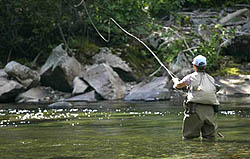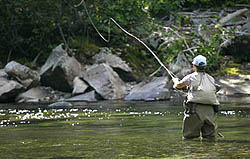In one of the classic essays in economics, Frederic Bastiat describes how breaking a windowpane generates two types of effects: the “seen” and the “unseen.” The seen effect is the window’s repair. A repairman replaces the window and receives payment for this service. Thus, broken windows make window repairmen better off. The unseen effect, however, is the lost opportunities for other businesses. The shoe maker, publisher and grocer are worse off – not better – because the money spent repairing the window could have gone to them but did not.
Bastiat wrote “What Is Seen and What Is Not Seen” to demonstrate how government-created jobs help some industries but hurt others. Such policies, Bastiat wrote, have invisible costs that often outweigh the visible benefits.
Unfortunately, the same principle applies to stream access in Montana. The invisible costs generated by Montana’s ever-expanding Stream Access Law vastly outweigh the visible benefits. Nowhere better is this demonstrated than on the Mitchell Slough.
In a 2008 Montana Supreme Court opinion, a small number of access advocates “won” public access to the Mitchell Slough, an irrigation ditch turned trout stream by private landowners. Newspapers and blogs described the case as a victory for anglers everywhere. The “public” had been granted access to a water body previously closed by wealthy out-of-state interests. These were the “seen” effects of the Mitchell Slough decision, but the Supreme Courts decision generated many “unseen” consequences as well.
For starters, landowners along the Mitchell lost the privacy of their own backyards. Though some of these landowners are wealthy non-residents, the majority are longtime Montana ranchers and farmers. Given the significant loss in property values, the Supreme Court’s decision favoring public access over private property rights likely hurt the resident landowners worse than the nonresidents.
Resulting from this loss of privacy, property rights and property values, the Mitchell landowners stopped managing the ditch as a trout fishery. Previous investments in habitat construction, costing approximately $1 million per mile, have been abandoned. With the Mitchell once again managed exclusively as an irrigation ditch, the most obvious victims are the trout. They no longer have access to the low-temperature, low-traffic waters that made the Mitchell ideal for spawning.
Ironically, the other invisible casualty of the Mitchell Slough decision is the quality of public fishing opportunities in the Bitterroot Valley. As sure as the sunrise, the loss of spawning habitat on the Mitchell will drive down trout numbers in the Bitterroot’s main channel. So, even though the public has access to more trout waters, fewer trout will occupy those waters than before when the Mitchell was private.
As if the loss in privacy, property values and public fishing opportunities were not enough to discourage other private land conservationists, the Mitchell landowners were recently ordered to pay $350,000 in BRPA’s attorney’s fees. The message to private landowners is clear: environmental stewardship will cost you. When landowners stop investing in environmental stewardship, Montanans will understand the unseen costs of stream access.
Bastiat’s broken window metaphor demonstrates how policies aimed at benefiting a small group of people impose unforeseen and often invisible costs on society as a whole. Such is the case with the Mitchell Slough. When the Bitterroot River Protective Association won public fishing access to the Mitchell, what was seen was the opening of prime fishing habitat to the public. What was unseen was the disincentive for private habitat conservation created by the Montana Supreme Court’s decision.
Reed Watson is a research fellow at the Property and Environment Research Center in Bozeman, and an attorney.




